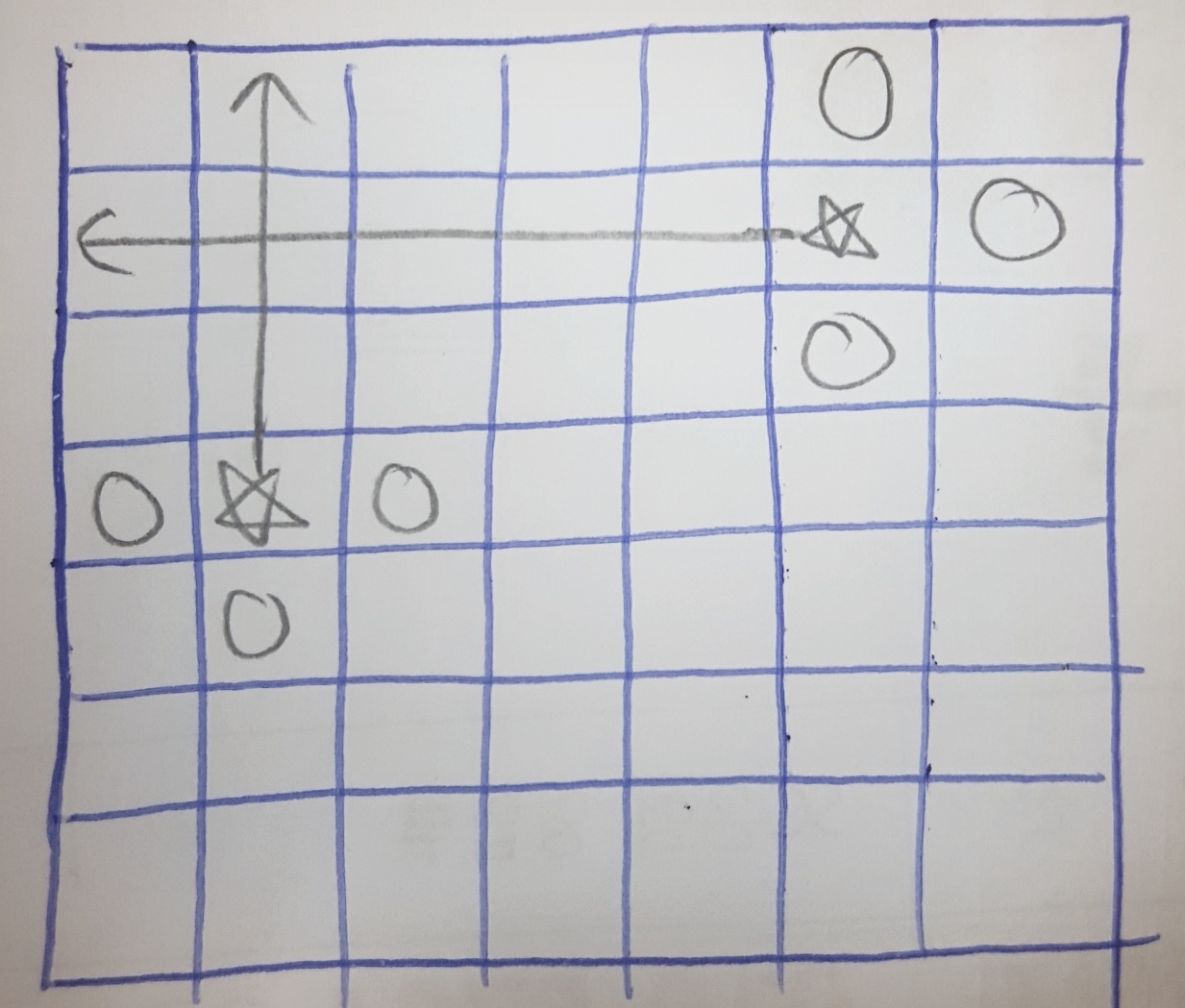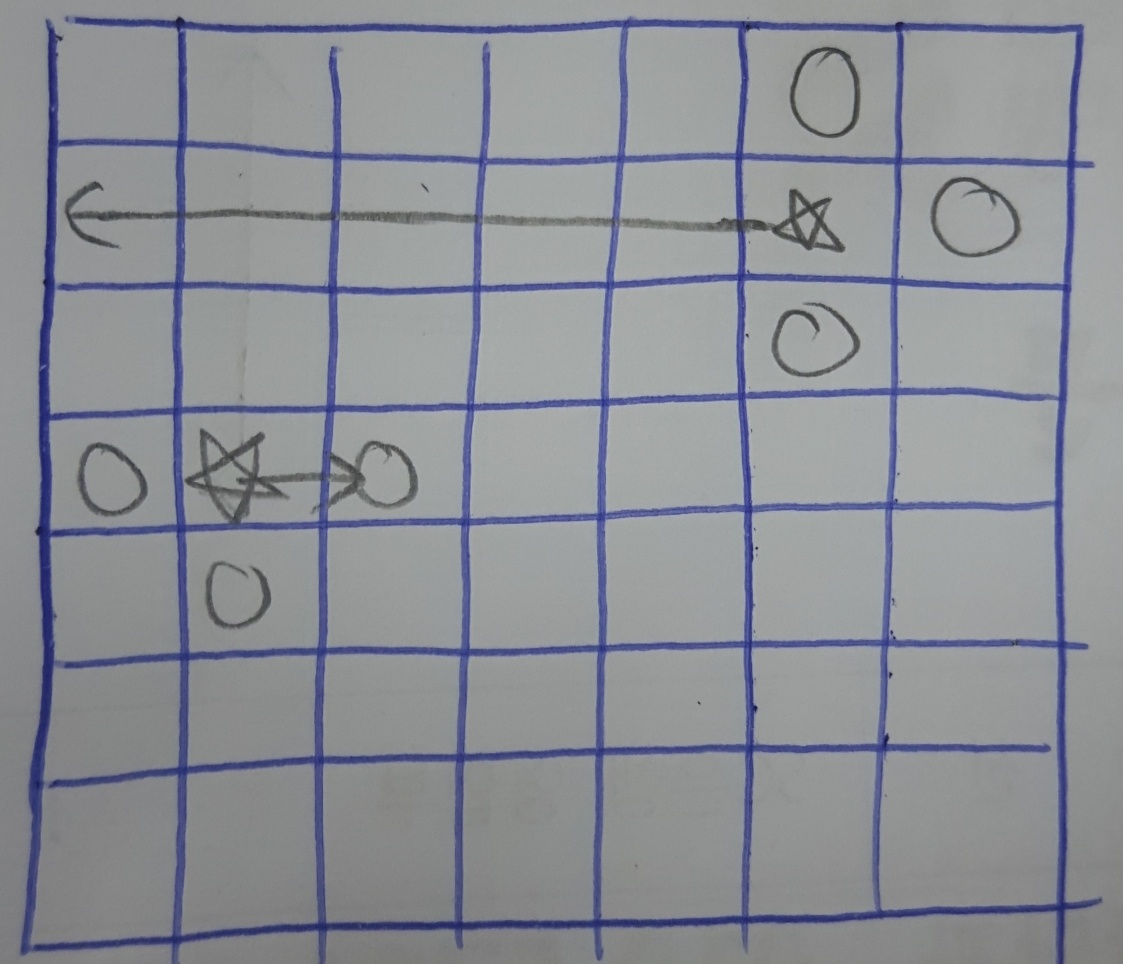[1767][미완성] 프로세서 연결하기
DFS 풀이
- 가장자리에 있지 않은 모든 코어를 queue에 넣는다.
- dfs(idx)를 진행하는데, idx는 몇 번째의 core에 대해서 4방향으로 연결을 시도할 것인지를 나타낸다.
- dfs(idx)의 종료 조건은 마지막 idx의 core까지 모두 연결을 시도한 순간이 된다.
- idx번째의 core에 대해서 4방향으로 연결을 시도하고, 만약 연결이 가능하면 idx번째의 core는 해당 방향으로 연결된 것으로 간주하고 dfs(idx+1)한다.
- 만약 4방향 모두로 연결이 불가능하다면 idx번째의 core는 연결이 불가능한 것이므로 dfs(idx+1)을 한다.
DFS 코드
//NOT-YET
#include <cstdio>
#include <cstring>
#include <vector>
using namespace std;
int map[12][12];
int dx[] = { 0,0,1,-1 };
int dy[] = { 1,-1,0,0 };
int n = 0;
pair<int, int> ans = { 0,0 };
//ans.first : 몇 개를 연결했는가?
//ans.second : ans.first개를 연결하기 위해서 몇 개의 전선을 사용했는가?
vector<pair<int, int> > core; //테두리에 있지 않은 코어들
void dfs(int idx, pair<int, int> tans) {
if (idx == core.size()) {
//모든 코어를 다 점검한 경우
if (ans.first < tans.first) ans = tans;
else if (ans.first == tans.first && ans.second > tans.second) ans = tans;
return;
}
int impos = 0;
for (int k = 0; k < 4; k++) {
if (connect(core[idx].first, core[idx].second, k)) {
tans.first += 1;
dfs(idx + 1, tans);
}
else impos += 1;
disconnect(core[idx].first, core[idx].second, k);
}
if (impos == 4) dfs(idx + 1, tans);
}
bool connect(int i, int j, int dir) {
//dir 방향으로 전선을 깔아보기
while (true) {
i += dx[dir];
j += dy[dir];
if (map[i][j] == 0) map[i][j] = 1;
else if(map[i][j] == 1)
}
return true;
}
bool disconnect(int i, int j, int dir) {
//dir 방향으로 전선을 지우기
return true;
}
int main(void) {
int tcase = 0; scanf("%d", &tcase);
for (int tc = 1; tc <= tcase; tc++) {
int ans = 0;
memset(map, 0, sizeof(map));
core.clear();
scanf("%d", &n);
for (int i = 0; i < n; i++) {
for (int j = 0; j < n; j++) {
scanf("%d", &map[i][j]);
if (i == 0 || i == n - 1) continue;
if (j == 0 || j == n - 1) continue;
if(map[i][j] == 1 ) core.push_back(make_pair(i, j));
}
}
dfs(0,make_pair(0,0));
printf("#%d %d\n", tc, ans);
}
return 0;
}
[시간초과 Brute-Force] 풀이
- N의 최대값이 12이고, 코어의 최대 갯수가 12개이므로 $$Brute-Force임을 짐작할 수 있다.
- 모든 경우의 수를 커버하는 방법은 다음과 같다. 각 시도마다 각각의 코어들이 연결될 방향이 결정되어 있다.
- 코어 A를 할당된 방향으로 연결하고 코어 B에 할당된 방향으로 연결하면서 전선이 겹친다면 이 경우를 그냥 제외하면 된다. 왜냐하면 코어 A와 B에 할당된 방향이 각각 전원과 연결될 가능성이 있는 유일한 방향이라면, 둘 중 하나만 유일한 가능성의 방향으로 할당되고, 나머지 하나는 아예 가능성이 없는 방향으로 할당된 경우의 수도 고려하기 때문에 모든 수를 고려할 수 있다. 아래와 같이 첫 번 째 사진의 경우를 무시해도 되는 것은 두, 세 번째의 경우를 모두 고려하기 때문이다.



구글 코드
#include <cstdio>
#include <vector>
using namespace std;
int t,n,map[12][12],cnt,cnt2,dx[4]={0,0,1,-1},dy[4]={1,-1,0,0},CORE,SUM;
vector<pair<int,int>> core;
vector<int> v;
void solve()
{
int tmap[12][12];
for(int i=0;i<n;i++) for(int j=0;j<n;j++) tmap[i][j]=map[i][j];
int sum=0,c=cnt2;
for(int i=0;i<cnt;i++)
{
int x=core[i].first,y=core[i].second;
while(true)
{
x+=dx[v[i]],y+=dy[v[i]];
if(x<0 || x>=n || y<0 || y>=n) { c++; break; }
if(tmap[x][y]==1) return;
else tmap[x][y]=1,sum++;
}
}
if(CORE<c) CORE=c,SUM=sum;
else if(CORE==c && SUM>sum) SUM=sum;
}
void go(int n)
{
if(n==cnt)
{
solve();
return;
}
for(int i=0;i<4;i++)
{
v.push_back(i);
go(n+1);
v.pop_back();
}
}
int main()
{
scanf("%d",&t);
for(int k=1;k<=t;k++)
{
scanf("%d",&n);
for(int i=0;i<n;i++)
{
for(int j=0;j<n;j++)
{
scanf("%d",&map[i][j]);
if(map[i][j]==1)
{
if(i==0 || i==n-1 || j==0 || j==n-1) cnt2++;
else core.push_back({i,j}),cnt++;
}
}
}
go(0);
printf("#%d %d\n",k,SUM);
core.clear(),cnt=cnt2=CORE=SUM=0;
}
return 0;
}
